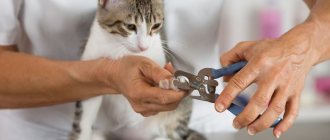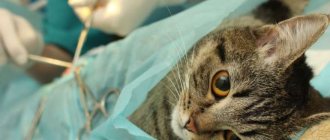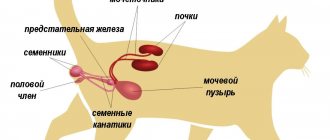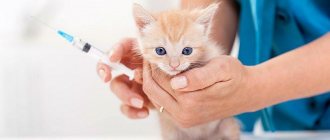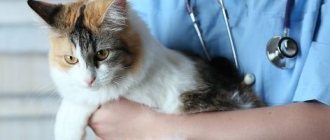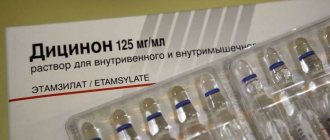During the operation, you can go to a veterinary clinic or call a specialist at home. There are no particular differences between these methods, since castration of a cat at home, subject to mandatory observance of the basic rules of sterility, takes place exactly as in a hospital setting.
Description of the procedure and indications for it
Castration is carried out for cats of any breed.
Castration of cats is carried out to eliminate periods of sexual heat in animals that do not have the opportunity to mate. The procedure simplifies the life of the owners and is required for the cats themselves, since if they cannot satisfy their mating needs, they begin to suffer from mental disorders and inflammatory diseases of the genitourinary system.
Free-roaming cats during the “wedding” period, when natural instinct pushes them to search for a cat, often die because they temporarily lose their sense of danger and lose vigilance.
Veterinarians also identify mandatory indications for castration, the main of which are:
- traumatic injury to the scrotum, spermatic canal or testis itself;
- pathologies in the development of the reproductive system;
- orchitis;
- special aggressiveness of the cat during the hunting period.
Castration of cats takes place under anesthesia, which is administered intravenously. Thanks to this, the animal does not experience pain during the operation. Anesthesia is maintained for 2-3 hours after surgery.
The hair from the scrotum is removed and incisions are made in the skin and lining of the testicles. The spermatic cords are then ligated and the testicles (testes) are cut off. A suture is not applied after the procedure, as it is not necessary.
Then the cat comes out of anesthesia on its own or is removed by a veterinarian using medications. The duration of the operation itself is 10 minutes.
Important! Despite the simplicity of the operation, it must be performed by a veterinarian with experience in operating cats.
Anatomy of the genital organs
The actual genital organs of cats are represented by the penis and testicles. The testicles consist of testes with appendages and the scrotum - a skin-muscular sac in which everything is located.
Scrotum
In cats, the scrotum is an unpaired sexual organ, which is divided into two parts only internally by the median septum. From the outside, the septum is visible in the form of a depression, which is called a suture or median groove of the scrotum.
In cats, the scrotum is located behind the hips and pelvis, near the anus. It has a cervix, the tapering part of the scrotum that meets the abdominal wall. As well as the head or main part, which actually forms the spherical shape of the scrotum.
Despite the apparent simplicity of the “bag,” it has a rather complex structure. There are several membranes in the scrotum, which are important to know when analyzing castration methods:
- Leather. On the scrotum it is thin and flexible, thanks to which it simply stretches. The dermis contains hair follicles, sebaceous and sweat glands. The subcutaneous fat layer is absent.
- Muscular-elastic membrane. Lines the skin of the scrotum from the inside instead of subcutaneous fatty tissue. Its basis is connective tissue, which is penetrated by a large number of elastic fibers and smooth muscles.
- Fascia of the scrotum. Covers its entire internal surface. On the outside, it is loosely connected to the muscular-elastic membrane. The inside is also loose - with the common vaginal or with the external levator testis.
- The external levator is the fibers of smooth muscle tissue that cover the fascia only partially, not reaching the median septum, and often line the fascia only from the side of the neck of the scrotum.
- Common tunica vaginalis. Created by fibrous and serous sheet. Covers the fascia of the scrotum and external levators. The common tunica vaginalis forms the common vaginal cavity and canal, which communicates with the abdominal cavity through the inguinal opening.
- Special vaginal membrane. It is a continuation of the peritoneum; it covers the outside of the testis. Together with the common vaginal cavity, it forms the common vaginal cavity and canal.
Testis and epididymis
The testis in cross section has the shape of an oval. Its basis is connective tissue, which forms the outer frame and internal partitions. Sperm mature in these chambers.
The testicular appendage is also created by connective tissue; it consists of a flat oblong body, a thick head and a narrowed part - the tail. The body and head are attached to the testis. The tail passes into the vas deferens.
The spermatic cord is the mesentery of the testis and epididymis with small inclusions of connective tissue. The spermatic artery and vein, lymphatic vessels pass through it, while nerves, the internal elevator and the vas deferens pass through the cord. In the testis, the artery creates a large number of convolutions, their function is to regulate pressure.
Methods of castration
The opinion that removal of testicles poses a danger to cats is erroneous.
A veterinarian can perform one of two types of surgery:
- Emasculation. A classic operation where the testicles are removed and the cat becomes unable to impregnate the cat and loses interest in mating. The animal does not mark in the house and does not suffer from an unsatisfied need for mating. This surgery is recommended by most veterinarians. It is safe for cats and completely eliminates the problems associated with the cat’s “wedding” period.
- Sterilization. A rarely used method, when the testes are preserved and the spermatic cords are pulled. The animal retains the desire to mate, marks its territory, calls the cat with a loud meow, but fertilization is impossible from it. The procedure is similar to that performed on cats where their tubes are tied (each epididymis and uterus are preserved) to prevent fertilization.
Be sure to read:
Is it necessary to sterilize a cat: at what age is it better, surgery for a nulliparous cat, pros and cons
The opinion that removal of testicles poses a danger to cats is erroneous . With proper care, your pet will recover quickly after surgery.
Temporary deprivation of reproduction
To temporarily suppress reproductive function, a Suprelorin implant is surgically implanted under the skin of the animal. The active ingredient is Deslorelin. About a month and a half after the procedure, the cat loses sexual desire and no longer pays attention to females.
One implant can work for at least a year. Despite all the advantages of this technique and the almost complete absence of side effects, it is not widespread in world veterinary practice. The main factor limiting the spread of this method of castration is the high cost of consumables. Not every breeder will agree to regularly shell out considerable sums if it is possible to carry out cheap and reliable surgical castration.
In addition (but there is no official confirmation yet), many veterinarians believe that Deslorelin, with long-term use, significantly increases the chances of testicular cancer. And other features of its constant use have not yet been studied.
Castration of a cat at home and in the clinic
Veterinary clinics that offer home visits often offer castration at home, which reduces the stress on the animal.
However, it is almost impossible to ensure sufficient sterility, and there is a risk of developing inflammation after castration. Another disadvantage of sterilization at home is that if complications develop due to anesthesia, the veterinarian may not be able to carry out all the necessary treatment measures.
At the same time, for overly emotional animals, visiting a veterinary clinic can be a difficult ordeal. Because of this, sometimes it is recommended to operate on such a cat at home, but only if the operation is performed by a specialist who has already successfully done this in an apartment.
Important! An operation at home will cost more than in a clinic, and the risk of complications will be higher.
Goal No. 4. Children happen after sex!!!!
Which need to go somewhere!!!!! In a year or two, all your friends and acquaintances will be gifted with the gratuitous offspring of a terrorist father... And they will look at you askance... as if you were a maniac and a pimp... And, what is most unpleasant, the children for the most part become unhappy... Because... having received such a gift as a gift a kitten, they don’t value it and they can easily bring it back to you (it’s a year old, like we’ve had enough of playing) or, even worse, throw it out into the street! Or the cat's owners will throw the entire litter outside at once. Yes, yes, this happens often! Believe my experience, a lot of people call the club to report babies found in trash cans and stairwells...
But I’m not just talking about outbred or half-bred matings. It turns out that no one needs breeding kittens in such numbers as one active male can produce with an active owner... That is, you are harming the breed by excessive reproduction (this concept should not be confused with breeding). Moreover, the owners probably did not think about the type, but rather thought more about the possibility of satisfying the cat or getting money for mating...
Moreover, at the same time, the prestige and price of the breed (and its breeding value) decreases... Which is simply painful for professional breeders and experts to see! Breeding should be carried out by professionals or amateur fanatics under the strict supervision of professional felinologists! This truth is known all over the world and has been tested by the practice of many breeds of animals (not just cats). Cynology and hippology have more experience in selection...
Benefits of the procedure
Castration is the only way to save a cat from suffering if he is not going to be bred and does not have the opportunity to mate regularly.
Castration is the only way to save a cat from suffering
The prejudice against surgery, which is often found among owners, is not justified.
The advantages of castration of cats are:
- preventing the development of a number of cancers;
- elimination of inflammatory processes in the cat’s reproductive system due to lack of mating;
- protecting the animal from death during the hunt in a fight with another male or due to loss of vigilance;
- eliminating the problem of cat marks appearing in the house;
- reduction of aggression in cats.
Castration in cats, like sterilization in cats, can be called a procedure that prolongs the life of pets.
Contraindications and disadvantages
Castration is a surgical procedure and has a number of contraindications. If they are present, the operation is dangerous for the life of the animal.
Be sure to read:
Castration of a cryptorchid cat: what is it, reasons, how to identify it, surgical technique, is it possible to remove one testicle
Manipulations are not carried out in the following cases:
- age up to 7 months and more than 8 years;
- epileptic seizures;
- severe exhaustion;
- inflammation of the respiratory tract (temporary contraindication until the pet recovers);
- severe pathologies of the cardiovascular system;
- renal or liver failure;
- asthma;
- anemia.
The cat's intolerance to anesthesia cannot be ruled out. The risk of this phenomenon can only be assessed by a veterinarian.
The disadvantages of castration include:
- risk of obesity;
- the need for prevention of urolithiasis;
- load on the body due to anesthesia.
The advantages of the operation outweigh the disadvantages, and it must be performed if the cat is not planned to be used for breeding.
Risk of surgery
The danger of castration is mainly associated with the development of complications. During surgery, severe bleeding may occur. Large loss of blood is the cause of death of the animal. If the rules of asepsis are not followed, the pet may become infected. Pathogenic flora attached to the surgical site or suture can form purulent inflammation, an abscess, and melting of tissues with pus. Sepsis often develops.
But in most cases, in the absence of diseases in the cat, the operation proceeds without serious consequences.
How to prepare a cat for castration
Preparing your pet for surgery consists of a general examination by a veterinarian to determine the absence of contraindications. A 12-hour fast is also prescribed before the procedure, which is required to prevent vomiting due to anesthesia.
The veterinarian who will perform the operation must warn the owner of the animal in advance about how to prepare the pet. Sometimes it may be necessary to give your cat a sedative or heart support. The need for additional measures depends on the condition of the cat and its age. The older the pet, the more health problems it has.
Postoperative period
The cat comes out of anesthesia from 15 minutes to 4 hours, it depends on the anesthetic. Owners sometimes leave him in a clinic for a day under the supervision of a doctor, but in a familiar environment the animal is more psychologically comfortable.
Caring for a cat after castration
If your pet goes home under anesthesia, it will require careful care:
- The cat is placed in a warm room on the floor so that it does not accidentally fall.
- Cover with a blanket: after anesthesia, thermoregulation is disrupted, body temperature drops to 36.5 - 37.
- Place it on its side so that the tongue does not sink in and block the access of oxygen.
- The room is twilight, bright light is annoying after anesthesia.
- Every half hour, change the position of the body to restore blood circulation.
- Moisturize the eyes with saline solution or drops without antibiotics. During anesthesia, they remain open, the mucous membrane dries out.
- Other animals and children are not allowed in: after waking up, the cat sometimes becomes aggressive.
- Periodically check the reaction by touching the paws and nose.
After waking up, the pet has difficulty getting up on its paws, moves with a staggering gait, coordination is restored after 8-12 hours, it will require increased attention:
- The castration wound swells and hurts; it is treated with a gauze swab with a solution of chlorhexidine, furatsilin, and hydrogen peroxide.
- A collar is placed around the neck to prevent him from licking the wound.
- A bowl of water is kept next to the bed: after waking up, the animal immediately goes to drink.
- On the first day there is no food, after anesthesia there is nausea.
- The filler is removed from the tray for a week; it gets into the wound and provokes inflammation.
- They do not allow you to move sharply or jump.
- They don’t scold you if your pet relieves itself in the wrong place. He remains under the influence of anesthesia for a day and is not aware of his own actions.
Swelling goes away after 2–4 days, the wound heals after 5–7 days.
Behavior after castration
After anesthesia, cats behave differently, here are possible behavior options:
- The pet wakes up, sees a familiar environment around it and falls asleep again. During waking hours, the owners place a tray with no filler and dishes with water nearby.
- The cat restlessly walks around the house, meows aimlessly, and licks its wound. This behavior indicates nervous tension. They take him in their arms, calm him down, and wait for him to fall asleep.
- The animal rushes around the apartment, hits objects, does not recognize the owner, is not given into the hands, and rushes at others. This behavior is associated with hallucinations and is called redirected aggression. Due to the pain, fear experienced, and the action of the anesthetic, the cat accumulates irritation and anger, which he splashes out on others. The pet is isolated in a room, left with water and a tray, and given time to calm down.
Over the next 3 to 5 days, the animal notices apathy, lethargy, or increased excitability and irritability. These conditions disappear by the end of the week, when the wound heals and the pain stops.
If a kitten was castrated before the first heat, the behavior does not change, it remains a teenage cat. In an animal older than a year, testosterone levels drop gradually, but behavior remains the same from 1 to 6 months. He temporarily continues to mark and call for a female: the older the pet, the longer the wait for positive behavioral changes.
Feeding after surgery
Within a week, the cat will recover from dehydration; you will need plenty of warm drinks. The first day he is not fed, for the next 3-4 days he is given light food: meat broth, liquid porridge with pieces of meat, natural yogurt.
After anesthesia, animals often have loose stools. For constipation, add flaxseed oil to food. For diarrhea, give nutritional supplements with lactobacilli.
On days 5–7 they return to their previous food.
The new diet becomes additional stress, so the diet is changed gradually, two weeks after the operation:
- Animals on industrial feed are transferred to lines for castrated cats. They contain components that prevent the deposition of stones and sand.
- Completely exclude fish and seafood due to excess magnesium and phosphorus.
- The amount of carbohydrates and fats is reduced by 30%.
- Fried, salty, fatty foods should not be given to any cat, but neutered ones are doubly contraindicated.
- Monitor water consumption: a cat weighing 4 kg needs 150 - 200 ml per day, an animal on dry food needs 1.5 times more. Lack of fluid is the main reason for the accumulation of sand in the bladder and kidneys.
Castrated animals have a slower metabolism, they sleep more and move less, so they gain excess weight faster. Portions are gradually reduced by 25%, physical activity is increased: they play, they take him out for walks on a harness.
Care and behavior after castration
After surgery, your pet requires special care. Due to anesthesia, the cat will suffer from incoordination problems for several hours. During this period, he may be injured by falling from a sofa or window sill, and may choke if he sticks his nose into a drinking bowl.
After surgery, your pet requires special care
Because of this, it is necessary to monitor the pet for several hours after the procedure. If the cat gets cold and starts to shiver, he can be warmed up by wrapping him in a warm blanket or sweater. You can let the animal out for a walk no earlier than 3 days after the operation. You can wash your pet after 2 weeks.
If the cat is easy to handle, then it is advisable to check the surgical area daily for inflammation and pus in the scrotal cavity until the incisions heal, which takes about a week.
Be sure to read:
Is it worth castrating a cat: optimal age, is it harmful, what will happen if the operation is not performed
The cat should be fed only when the anesthesia has completely worn off. The animal does not require a special diet when recovering from castration. If you use ready-made food, then you need to choose a brand for neutered cats.
Obesity prevention
Many owners are concerned about the question: what needs to be done to prevent their pet from gaining weight? Everything is quite simple: you need to reduce the usual portion by 10-20%. If the cat eats industrial food, you can replace the usual food with specialized food for castrates (in this case, there is no need to reduce the portion, since such food is balanced in composition). It is not recommended to feed the cat the same foods that are harmful to any cat: raw fish, fatty and salty foods, sausages, flour, sweets.
How much does the procedure cost?
The cost of the operation depends on which veterinary clinic it is performed at. Elite private clinics can price the procedure at 6-7 thousand.
Mid-level private clinics usually charge from 1.5 to 2 thousand for castration of a cat. State veterinary clinics provide services for 1-1.5 thousand.
Additional medications that are sometimes prescribed to cats for health reasons can increase the price. This is discussed in advance with the owner of the animal. Surgery on a very large pet, which requires an increased dose of anesthesia, is more expensive.
At what age can a cat be neutered?
Castration is allowed only from the moment when the animal’s reproductive system is already sufficiently developed , and the cat itself has almost reached its adult size. The optimal time for the procedure is from 8 to 12 months. If necessary, surgery is possible from 7 months.
Cats that have already experienced sexual heat endure castration more severely and take longer to recover. Such an animal may retain the habit of marking in the house. Older pets cannot be neutered due to the risk of serious complications from the effects of anesthesia. Their procedure is carried out only according to indications.
When is it time to spay a cat?
- Your cat has reached childbearing age (this figure varies for different breeds - but usually a cat can become pregnant at 7-8 months, a year or a little more)
- You have made a firm decision that you do not want offspring from your pet
- Your cat comes into heat more than four times a year. This is dangerous; there is a high risk of developing breast and uterine tumors. Sterilization will help preserve the health of the cat and extend its life.
Laparoscopic sterilization of a cat involves removal of the ovaries (oophorectomy). This operation is usually indicated for young cats before the first episode of heat occurs.

